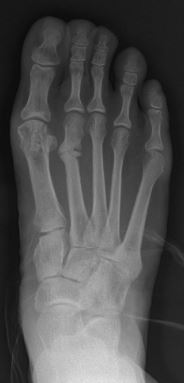Stress fracture
Editor-In-Chief: Prab R Tumpati, MD
Obesity, Sleep & Internal medicine
Founder, WikiMD Wellnesspedia &
W8MD medical weight loss NYC and sleep center NYC
| Stress fracture | |
|---|---|
| Synonyms | N/A |
| Pronounce | N/A |
| Specialty | N/A |
| Symptoms | Pain in the affected area, swelling, tenderness |
| Complications | N/A |
| Onset | Gradual |
| Duration | Weeks to months |
| Types | N/A |
| Causes | Repetitive mechanical stress |
| Risks | Athletes, military recruits, osteoporosis |
| Diagnosis | Physical examination, X-ray, MRI |
| Differential diagnosis | Tendonitis, arthritis, bone tumor |
| Prevention | Gradual increase in activity, proper footwear |
| Treatment | Rest, ice, compression, elevation, physical therapy |
| Medication | N/A |
| Prognosis | Good with proper treatment |
| Frequency | Common in athletes and military recruits |
| Deaths | N/A |
Stress Fractures[edit | edit source]
Stress fractures are small breaks or cracks in the bones, typically resulting from repeated pressure or stress on the bone over time. Unlike acute fractures that occur due to a single, severe impact, stress fractures develop gradually as a result of overuse and repetitive force. They are common in weight-bearing bones of the lower leg and foot, often affecting athletes and individuals engaged in high-impact sports.
Causes[edit | edit source]
Stress fractures are primarily caused by:
- Repetitive activity
- Increased physical activity without proper conditioning
- Impact on hard surfaces
- Poor equipment, such as worn-out shoes
Risk Factors[edit | edit source]
Factors that increase the risk of stress fractures include:
- Participation in high-impact sports like running, basketball, and gymnastics
- Conditions such as osteoporosis that weaken bones
- A sudden increase in physical activity intensity or duration
- Improper footwear
Symptoms[edit | edit source]
Symptoms of a stress fracture include:
- Pain that worsens with activity and improves with rest
- Swelling at the site of the fracture
- Tenderness to touch at the fracture site
- Possible bruising
Diagnosis[edit | edit source]
Diagnosis of a stress fracture involves:
- Medical history and physical examination
- Imaging tests such as X-rays, although early stress fractures may not always be visible. MRI or bone scan may be recommended for a more accurate diagnosis.
[[File:Occult stress fracture of the talus on 1 month follow-up T1 MRI.jpg|left|thumb|Occult stress fracture of the talus on 1 month follow-up T1 MRI]]
Treatment[edit | edit source]
The primary treatment for stress fractures is rest and avoidance of the activity that caused the injury. Additional treatments include:
- Protective footwear or braces
- Physical therapy to strengthen surrounding muscles
- Gradual return to activity following a period of rest
Prevention[edit | edit source]
Prevention strategies for stress fractures include:
- Gradually increasing the intensity and duration of physical activity
- Using appropriate and well-fitting footwear
- Cross-training to avoid repetitive stress on one area of the body
- Ensuring adequate nutrition, particularly calcium and vitamin D intake
See Also[edit | edit source]
References[edit | edit source]
- American Academy of Orthopaedic Surgeons. (2021). Stress Fractures.
- National Institute of Arthritis and Musculoskeletal and Skin Diseases. (2020). Stress Fractures.
External Links[edit | edit source]
Transform your life with W8MD's budget GLP1 injections from $125 and up biweekly
W8MD offers a medical weight loss program NYC and a clinic to lose weight in Philadelphia. Our W8MD's physician supervised medical weight loss centers in NYC provides expert medical guidance, and offers telemedicine options for convenience.
Why choose W8MD?
- Comprehensive care with FDA-approved weight loss medications including:
- loss injections in NYC both generic and brand names:
- weight loss medications including Phentermine, Qsymia, Contrave, Diethylpropion etc.
- Accept most insurances for visits or discounted self pay cost.
- Generic weight loss injections starting from just $125.00 for the starting dose
- In person weight loss NYC and telemedicine medical weight loss options in New York city available
Book Your Appointment
Start your NYC weight loss journey today at our NYC medical weight loss, and Philadelphia and visit Philadelphia medical weight loss Call (718)946-5500 for NY and 215 676 2334 for PA
Search WikiMD
Ad.Tired of being Overweight? Try W8MD's NYC physician weight loss.
Semaglutide (Ozempic / Wegovy and Tirzepatide (Mounjaro / Zepbound) available. Call 718 946 5500.
Advertise on WikiMD
|
WikiMD's Wellness Encyclopedia |
| Let Food Be Thy Medicine Medicine Thy Food - Hippocrates |
Translate this page: - East Asian
中文,
日本,
한국어,
South Asian
हिन्दी,
தமிழ்,
తెలుగు,
Urdu,
ಕನ್ನಡ,
Southeast Asian
Indonesian,
Vietnamese,
Thai,
မြန်မာဘာသာ,
বাংলা
European
español,
Deutsch,
français,
Greek,
português do Brasil,
polski,
română,
русский,
Nederlands,
norsk,
svenska,
suomi,
Italian
Middle Eastern & African
عربى,
Turkish,
Persian,
Hebrew,
Afrikaans,
isiZulu,
Kiswahili,
Other
Bulgarian,
Hungarian,
Czech,
Swedish,
മലയാളം,
मराठी,
ਪੰਜਾਬੀ,
ગુજરાતી,
Portuguese,
Ukrainian
Medical Disclaimer: WikiMD is not a substitute for professional medical advice. The information on WikiMD is provided as an information resource only, may be incorrect, outdated or misleading, and is not to be used or relied on for any diagnostic or treatment purposes. Please consult your health care provider before making any healthcare decisions or for guidance about a specific medical condition. WikiMD expressly disclaims responsibility, and shall have no liability, for any damages, loss, injury, or liability whatsoever suffered as a result of your reliance on the information contained in this site. By visiting this site you agree to the foregoing terms and conditions, which may from time to time be changed or supplemented by WikiMD. If you do not agree to the foregoing terms and conditions, you should not enter or use this site. See full disclaimer.
Credits:Most images are courtesy of Wikimedia commons, and templates, categories Wikipedia, licensed under CC BY SA or similar.
Contributors: Prab R. Tumpati, MD





